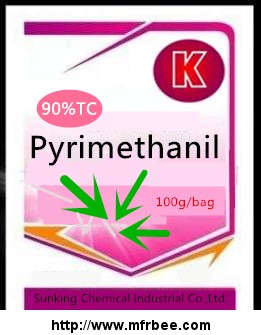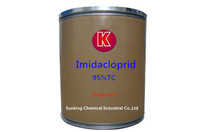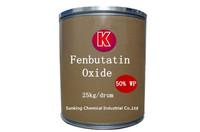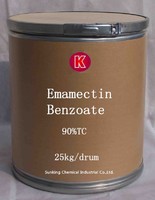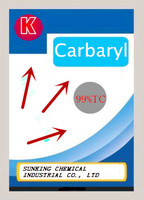Pyrimethanil 90%TC,40%SC
Product Quick Detail
- Packaging
- Solid: 100g/bag 500g/bag 1kg/bag 5kg/bag 25kg/bag or according to your order. Liquid: 100ml/bottle 200ml/bottle 250ml/bag 500ml/
- Delivery
- N/A
Specifications
Physical Chemistry:White to gray crystals ,Melting point 96.3C ,Vapor pressure(25C):2.2mPa ,Densities :1.15(20C),Stability :water 0.121g/l ,acetone :389 ,methyanol :176 ,dichlormethane:1000 ,toluene:412(g/l ,20C).Stable in water within the relevant pH range .Stable for two weeks at54C. pKa 3.52 (20C).
Toxicity: Pyrimethanil has low level toxicity .Acute oral LD50 for rats 4150 to 5971mg/kg ,Accute skin and eye LD50 for rats and mice 2000mg/kg ,Non-irritating to sking to skin and eyes of rabbits .It is not carcinogens ,teralogenisis and mutagemesis .ADI 0.17 to 0.2mg/kg .
Uses: It has good effective to control of gray mould on vines ,fruit(such as strawberry), vegetables(such as tomato and cucumber)and ornamentals ,control of leaf scab on pome fruit such as apple and pear.
Biochemistry and Mode of Action:Pyrimethanil is one of the anilinopyrimidine fungicide with low toxicity and high performance .It has protective activity in control of gray mould and both protective and curative activity in control of leaf scab .It is inbibitor of methionine biosynthesis leading to inhibition of the secretion of enzymes necessary for infection.
Application:Applied as a foliar spray at 375 to 562.5g a.i./ha every seven days to ten days after initial stage of disease.First-Aid:If someone happened to be poisoned,
be sure to be sent to hospital with the label immediately.
Precaution: Paying much attention to be safe in storage use and disposal .
n>`Jns�30@4t-family:宋体; font-size:10.5000pt; mso-font-kerning:1.0000pt; " >Systemic foliar fungicide with protective and curative action, with translocation acropetally in the xylem.
Toxicity Data:
| Organism | Test Type | Route | Reported Dose (Normalized Dose) |
| rat | LC50 | inhalation | 1264mg/m3/4H (1264mg/m3) |
| rat | LD50 | oral | 1517mg/kg (1517mg/kg) |
| rat | LD50 | skin | > 4gm/kg (4000mg/kg) |
ENVIRONMENTAL FATE:
Animals: After oral administration to the rat, propiconazole is rapidly absorbed and also rapidly and almost completely eliminated with urine and faeces. Residues in tissues were generally low and there was no evidence for accumulation or retention of propiconazole or its metabolites. The major sites of enzymic attack are the propyl side-chain and the cleavage of the dioxolane ring, together with some attack at the 2,4-dichlorophenyl and 1,2,4-triazole rings. In the mouse, the major metabolic pathway is via cleavage of the dioxolane ring (R. Bissig & W. Muecke, Br. Crop Prot. Conf. - Pests Dis. , 1988, 2 , 675-680).
Plants: Degradation proceeds through hydroxylation of the n -propyl side-chain and deketalisation of the dioxolan ring. After cleavage of triazole, triazole-alanine is formed as the main metabolite. Metabolites are conjugated mostly as glucosides. For details of metabolites of propiconazole in wheat, rice and vines, see B. Donzel et al., IUPAC 7th Int. Congr. Pestic. Chem. , 1990, 2 , 160.
Soil/Environment: DT 50 in aerobic soils (25 oC) 40-70 d. The main degradation pathways are hydroxylation of the propyl side-chain and the dioxolane ring, and finally formation of 1,2,4-triazole. K oc (ads) 950 ml/g, immobile in soil.
- Country: China (Mainland)
- Address: Mingshu Rd, Jiangshan Ind Zone, Yinzhou, Ningbo , China
- Contact: Teng Xia
